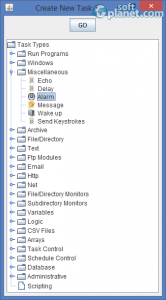

- AUTOMIZE CHANGES FILE DATA ON COPY HOW TO
- AUTOMIZE CHANGES FILE DATA ON COPY MANUAL
- AUTOMIZE CHANGES FILE DATA ON COPY WINDOWS 10
- AUTOMIZE CHANGES FILE DATA ON COPY SERIES
u Copies files from Source that exist on destination only. f Displays source and destination file names while copying. You can add any switch you need as following: If you want to create backup batch file with xcopy, the basic command is: xcopy Then, insert the backup command before “PAUSE”. Otherwise it will close as soon as the script finishes running. *“PAUSE” ensures the window will open after executing the command. If you want any text to be displayed after the operation is completed, enter the following OFF You could search it on taskbar, or right-click on the desktop, choose New > Text Document to create a new text file.Ģ.
AUTOMIZE CHANGES FILE DATA ON COPY WINDOWS 10
Way 1: Create batch file to backup files in Windows 10 step by stepġ. If you have further backup needs, please refer to the next method. Please note: You could use batch file to copy (or synchronize) important files & folders as a backup, but none of the commands could create image backup, neither can it keep different versions of data for accurate recovery. Also, there’s robocopy that functionally replaces xcopy and provides more options. Furthermore, you could use Windows Task Scheduler to run the task on regular basis.Īmong the commands that apply in this case, copy is for files only while xcopy works on both files and folders, so the latter is more popular. Thus every time you double-click the script file, these commands will be performed automatically.
AUTOMIZE CHANGES FILE DATA ON COPY HOW TO
How to create backup batch file in Windows 10įirst, you need a text editor to input the backup commands and save it with.

AUTOMIZE CHANGES FILE DATA ON COPY MANUAL
automating everyday tasks to avoid repetitive manual operation. Usually, you can use it for “batch processing”, e.g.
AUTOMIZE CHANGES FILE DATA ON COPY SERIES
bat extension) consists of a series of command lines that executed by Command Prompt. In Windows 10, a batch file is a script file (with. Rather, you will simply be issued a credential with the default lifetime that the identity provider is configured to issue - typically 10 days.What is batch file? Can you use it for backup? When activating on GCSv4 endpoints that use a CILogon identity provider there is no way to request a specific credential lifetime. However, no matter what credential lifetime you request, you will never be issued a credential that is longer than the maximum credential lifetime than the MyProxy server is configured to issue. Globus endpoint activate command with the -proxy-lifetime option, or in the web interface by clicking on the "advanced" link on the web page when prompted to authenticate to the GCSv4 endpoint. You can do this on the Globus command line interface by using the Provider, you can specify the lifetime of the credential you are requesting. When authenticating on a GCSv4 endpoint that uses a MyProxy identity Longer than the maximum credential lifetime for which an identity provider isĬonfigured. It is not possible for an end user to be issued credentials that will last Large files over high latency links can benefit from higher parallelism. Parallelism can divide and send a file’s data blocks over multiple TCP streams, however, all the TCP streams have the same source and destination GridFTP server process. Regular FTP sends a file over one TCP stream, which isn’t ideal for high latency, high throughput links. So concurrency is great for driving more filesystem processes, CPU cores, and even machine nodes, in addition to opening more network data streams. Also note that each session may be to a different server if you had DNS round robining, a load balancer, or multiple physical DTNs defined in Globus. Files are divided among the sessions, so this only works if you have multiple files in a job (most users do).

Thus, a concurrency (cc) of 4 would drive 4 GridFTP processes, so you have 4 processes driving IO (each one working on a different file). Each login session starts a GridFTP process on the server, usually via xinetd. Opens multiple login sessions (also known as control channel sessions).


 0 kommentar(er)
0 kommentar(er)
